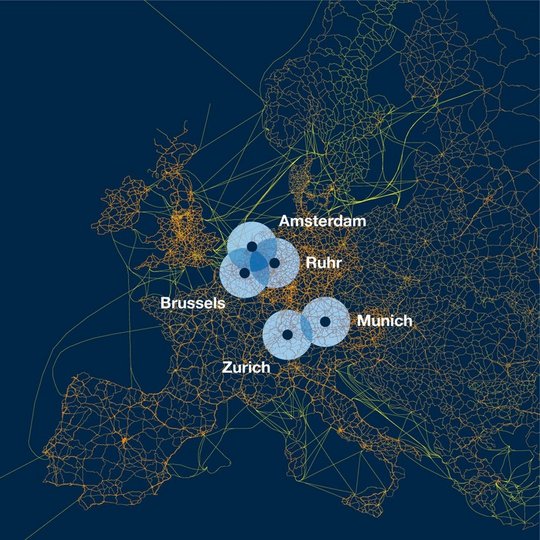Theme:
The aim of the conference and related research ‘Shaping regional futures’ is to clarify a performance of regional design: the way how the imagination and envisioning of spatial futures of regions enhances planning on regional and supra-regional levels of scale. Regional design will be investigated as an institutional practice. From this perspective it is a form of analytical reasoning, political advocacy and organisational pragmatism, used to challenge, within a given freedom for interpretation, planning in place. Seen from an institutional perspective regional design is also a way to involve decision-makers, politicians, authorities, experts and a broader public, in learning about why and how to become involved in regional planning. Relationships among authors of regional designs and their audience are a key for the performance of a practice that relies on imagination, representations of what is possible and desired.
In numerous European regions politicians, administrations, planning professionals, market and civil actors are experimenting with regional design approaches to overcome limitations that statutory planning systems pose. They use the practice to indicate how a growing spatial integration exceeds restricting administrative boundaries and to demonstrate why and how such barriers should be overcome. Regional design practices in European regions vary highly. In some regions they are a commonly used planning endeavour; in others they have not been applied yet – but actors curiously observe the efforts taken elsewhere. Despite the broad interest in practices, few lessons have been learnt from a comparison of practices.
The joint conference and research activities of TU München and TU Delft are an occasion to compare regional design strategies that are used in different European regions, to discuss the different facets and dimensions of these practices and to assess their performance.
Summary:
The research programme ‘Shaping regional futures’ proposes a systemic view on regional design. Regional design shall be discussed from three interrelated perspectives:
-
The regional setting as the specific context any design endeavour is embedded in
-
The regional design endeavour that can be split up into the regional design strategy and the design process it arises from
-
The impact of regional design that can be conceived as three interrelated processes of regional development
This preliminary framework shall guide the discussion of the regional design cases. The framework is neither complete nor exclusive – it provides a discursive structure for the conference and related research that shall be debated, complemented and revised. The point of departure is not a fixed idea of what regional design actually is or what kind of expectations and impact regional design has to meet. The three interrelated perspectives shall promote a joint reflection on regional design from a performance perspective.
Regional Design: What kind of setting?
Regional design takes place in a setting where a whole range of boundaries has become blurred. Being fuzzy at the edges relates to space, actors as well as to knowledge about spatial dynamics. Spatially it is virtually impossible to demarcate ‘the’ region. Spaces and places are connected in many different ways, leading to complex, multi-scalar inter-relations. The administrative borders of local and regional government can no longer match these relations. Formal supra-local planning does not deliver strong enough orientation about potentialities of space. Complexity of governance increases through a search for novel relationships between public, private and science-related actors. What constitutes valid knowledge is not self-evident in these new relationships, often even contested. Regional design – as a form of informal planning approach – then becomes a matter of creating institutional capacity – but how to demark the region in a situation of multi-scalarity?
Regional design: What kind of performance?
If indeed regional design is about creating institutional capacity, what does this entail? Does it relate to: a) a shared framing of territories; 2) the formation of actor networks; 3) bringing together different types of knowledge; 4) imagining trajectories of concrete spatial transformation? Can we develop a small set of criteria about the transformative power of regional design? Where, why and when does regional design depart from formal planning? And if so, what does this mean for design processes?
Regional design: What kind of design?
Regional design takes place in an urban reality, which is highly complex: many ‘things’ are connected with many other ‘things’ an many actors are connected with many other actors. This calls for systemic approaches. Nevertheless regional designs calls for being selective. But how to select sub-spaces, activities, themes, projects with magnitude and impact? Are there specific methods to be used that are more apt then others? And how to apply such methods in complex multi-actor and multi-scalar settings? How to bring the different language domains – verbal, visual, emotional – of regional design together?
Issues to be investigated in the regional design cases
-
What key issues drive the case?
-
What were the intentions?
-
How was the region defined?
-
How was the process organized?
-
Which actors participated?
-
What kind of impacts, from ‘soft’ to ‘hard’?
-
Where there non-intended impacts such as ‘learning’ or ‘conflicts’?
Team Members Involved:
Dr. Agnes Förster, Prof. Dr. Alain Thierstein
Collaboration Partners:
Verena Balz, Prof. Dr. Wil Zonneveld, Professor of Urban and Regional Planning Chair of Spatial Planning & Strategy, Faculty of Architecture, TU Delft www.spatialplanning.bk.tudelft.nl
